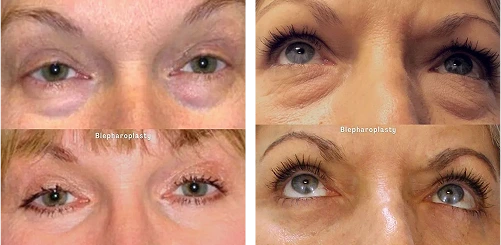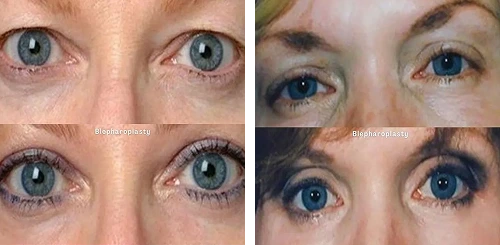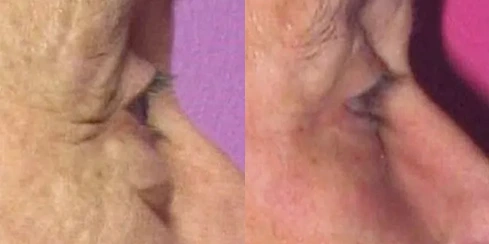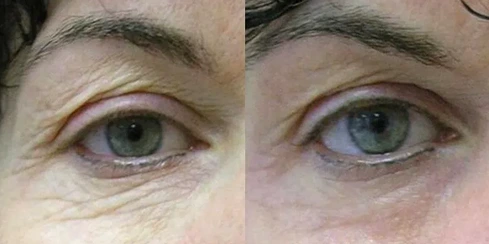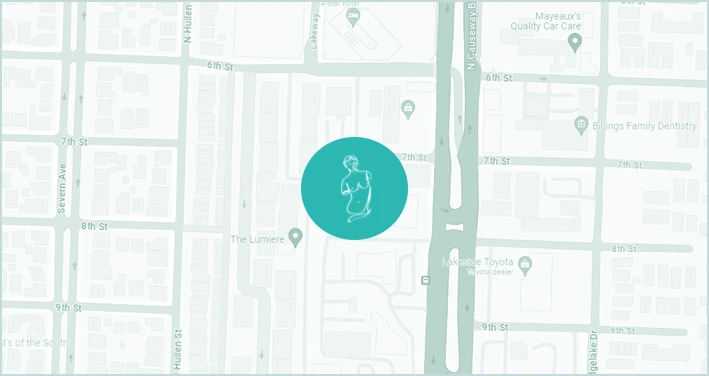Table of Contents
Blepharoplasty, or eyelid surgery, is a cosmetic procedure that enhances the appearance of the eyes by removing excess skin, fat, and sagging tissue. While the procedure itself is relatively straightforward, the recovery process requires patience, proper care, and realistic expectations.
In the first few days after surgery, patients can expect swelling, bruising, blurry vision, and a sensation of tightness around the eyes. These effects are temporary, but following post-operative care instructions is crucial for a smooth recovery. Most individuals see noticeable improvements within two weeks, but complete healing can take several months. Factors such as age, skin type, and overall health play a role in how quickly the body recovers.
The recovery experience differs between upper and lower blepharoplasty. The upper eyelids generally heal faster, while lower eyelid surgery may involve more swelling and a longer period before final results are visible. Knowing what to expect at each stage can help reduce anxiety and improve the overall healing process.
This guide will outline the blepharoplasty recovery timeline, common symptoms, and essential aftercare tips. By following the recommendations of Dr. Metzinger and taking proactive steps during recovery, patients can achieve optimal results and enjoy a more youthful, refreshed appearance.
What to Expect Day by Day
Recovery after blepharoplasty follows a predictable timeline, though individual healing speeds may vary. Understanding what to expect during each phase can help patients feel more at ease and take the right precautions to promote healing.
First 24 to 48 hours
- Swelling and bruising peak during this time.
- The eyes may feel tight, tender, and watery.
- Some patients experience mild discomfort, but pain is usually minimal.
- Blurry vision is common due to protective antibiotic ointment applied during surgery.
- Cold compresses and keeping the head elevated can help reduce swelling.
Days 3 to 7
- Bruising and swelling start to subside.
- Stitches, if non-dissolvable, are usually removed around day 5 to 7.
- Some patients may feel eye dryness or slight irritation.
- Light activities can be resumed, but strenuous exercise and bending over should be avoided
- Sunglasses should be worn outdoors to protect the eyes from wind, dust, and sunlight.
Week 2 to 4
- Most bruising fades, and swelling continues to improve.
- Patients generally feel comfortable returning to work and social activities.
- Contact lenses can usually be worn again after two weeks, with a doctor’s approval.
- Light makeup may be applied after 10 to 14 days to conceal residual bruising.
Months 2 to 6
- Scars gradually fade and become less noticeable.
- Residual swelling disappears, revealing final results.
- The eyes appear more open, refreshed, and youthful.
Common Symptoms During Blepharoplasty Recovery
Blepharoplasty recovery is generally well tolerated, but patients should expect some temporary side effects as the body heals. While these symptoms are normal, knowing what to expect can help reduce anxiety and ensure a smoother recovery.
Swelling and Bruising
Swelling is most pronounced in the first few days and gradually decreases over the following weeks. Bruising typically starts as dark purple or red and fades to yellow or green before disappearing completely. Applying cold compresses and keeping the head elevated can help minimize these effects.
Blurred Vision and Eye Dryness
Many patients experience blurry vision due to post-surgical swelling or the use of antibiotic ointment. This typically resolves within a few days. Dryness, itching, and a gritty sensation in the eyes are also common. Surgeons often recommend lubricating eye drops to keep the eyes comfortable.
Tightness and Numbness
The eyelid area may feel tight or slightly numb due to the healing process. This sensation improves over time as swelling subsides and nerve endings regenerate.
Increased Tear Production or Light Sensitivity
Some individuals experience excessive tearing or sensitivity to light in the early stages of recovery. Wearing sunglasses outdoors can help protect the eyes and reduce discomfort.
Most of these symptoms improve significantly within the first two weeks. However, patients should report any severe pain, unusual swelling, or vision changes to their surgeon promptly.
Recovery from Upper vs. Lower Blepharoplasty: What to Expect
The recovery experience varies depending on whether a patient undergoes upper blepharoplasty, lower blepharoplasty, or a combination of both. While both procedures involve swelling and bruising, lower eyelid surgery often requires a longer healing period due to the delicate nature of the under-eye area.
Upper Blepharoplasty Recovery
- Swelling and bruising are generally less severe and resolve more quickly.
- Stitches are typically removed within five to seven days, with scars hidden in the natural eyelid crease.
- Most patients can resume work and social activities by the end of the second week.
- Vision disturbances, such as temporary blurriness or light sensitivity, are mild and usually clear within the first few days.
Lower Blepharoplasty Recovery
- Swelling tends to be more pronounced, especially if fat removal or skin tightening is involved.
- Bruising may extend down into the cheeks, taking longer to fade.
- Dry eyes, irritation, or excess tearing are more common and may require prescribed eye drops.
- If an incision is made inside the lower eyelid (transconjunctival approach), there are no external stitches, reducing visible scarring.
- Full results take several months to appear, though most patients feel comfortable in public after three to four weeks.
When to Contact Your Surgeon During Recovery
Most symptoms during blepharoplasty recovery are temporary and resolve with proper care. However, certain signs may indicate complications that require immediate medical attention. Patients should monitor their healing progress and contact their surgeon if any unusual symptoms arise.
Signs of Normal Healing
- Mild to moderate swelling and bruising that gradually improves.
- Temporary blurred vision or dry eyes that respond to lubricating drops.
- Mild discomfort is managed with prescribed or over-the-counter pain relievers.
When to Call Your Surgeon
- Excessive swelling or bruising that worsens instead of improving.
- Severe pain that is not relieved by medication.
- Persistent vision disturbances, such as double vision or significant blurriness beyond the first few days.
- Signs of infection, including redness, warmth, increasing pain, or pus-like discharge from the incision sites.
- Sudden bleeding that does not stop with gentle pressure.
- Asymmetry or unusual eyelid positioning that develops after surgery.
While complications are rare, addressing concerns early can prevent further issues and support proper healing. Patients should also attend all scheduled follow-up appointments to ensure recovery is progressing as expected.
What to Expect and Do
Proper post-operative care is essential for a smooth blepharoplasty recovery and achieving the best possible results. Following these guidelines can help reduce swelling, prevent complications, and promote faster healing.
Follow Your Surgeon’s Instructions
Each patient receives specific aftercare instructions tailored to their procedure. It is crucial to follow these directions regarding medications, wound care, and activity restrictions.
Keep the Head Elevated
Sleeping with the head elevated using extra pillows or a reclining chair for at least the first week helps minimize swelling and fluid retention.
Use Cold Compresses
Applying cold compresses or ice packs during the first 48 hours can significantly reduce swelling and bruising. However, compresses should never be placed directly on the eyes—using a clean cloth as a barrier is recommended.
Avoid Strenuous Activities
Patients should limit bending, lifting, and vigorous exercise for at least two weeks to prevent excessive swelling and strain on the healing tissues. Light walking is encouraged to promote circulation.
Be Gentle with Incision Care
The eyelid incisions should be kept clean and dry. Avoid rubbing or touching the area, and use any prescribed ointments as directed to prevent infection.
Protect the Eyes from Irritants
Wearing sunglasses outdoors can protect the eyes from wind, dust, and sunlight, reducing irritation and sensitivity. Contact lenses and eye makeup should be avoided until cleared by the surgeon.
Medications and Pain Management
Pain after blepharoplasty is typically mild, but proper medication use is essential for a comfortable recovery. Most patients experience tightness, soreness, or mild discomfort rather than severe pain. Managing these symptoms effectively can help ensure a smooth healing process.
Prescribed and Over-the-Counter Pain Relievers
Surgeons often recommend acetaminophen (Tylenol) to manage mild discomfort. Nonsteroidal anti-inflammatory drugs (NSAIDs) like ibuprofen or aspirin should generally be avoided in the first few days, as they can increase the risk of bruising and bleeding.
Antibiotic Ointments and Eye Drops
Patients may be prescribed a topical antibiotic ointment to prevent infection at the incision sites. Lubricating eye drops or artificial tears can help relieve temporary dryness and irritation.
Cold Therapy for Pain and Swelling
Using cold compresses during the first 48 hours can help reduce swelling and provide natural pain relief. Compresses should be applied gently and intermittently to avoid excessive pressure on the delicate eyelid area.
Avoiding Medications That Interfere with Healing
Certain supplements and medications, such as blood thinners, vitamin E, and fish oil, should be avoided unless approved by the surgeon. Alcohol and excessive caffeine intake can also contribute to swelling and prolonged bruising.
Diet and Nutrition for Faster Blepharoplasty Recovery
A well-balanced diet is essential for a smooth blepharoplasty recovery. Proper nutrition helps reduce swelling, promote tissue repair, and support overall healing. Eating the right foods can enhance recovery, while certain dietary choices may increase inflammation and slow down the healing process.
Hydration is Essential
Drinking plenty of water is crucial after surgery. Staying hydrated helps flush out toxins, reduces swelling, and keeps the skin moisturized. Patients should aim for at least eight glasses of water daily. Herbal teas and electrolyte-rich drinks can also be beneficial, but caffeinated and sugary beverages should be limited.
Anti-Inflammatory Foods to Include
A diet rich in antioxidants, vitamins, and proteins can support the body’s natural healing process. Some of the best foods for recovery include:
- Leafy greens such as spinach, kale, and Swiss chard, which are packed with vitamins A and C to support skin repair.
- Berries like blueberries, strawberries, and raspberries, which contain antioxidants that help reduce inflammation.
- Fatty fish such as salmon and mackerel, which provide omega-3 fatty acids to minimize swelling.
- Nuts and seeds, including almonds and walnuts, which are high in vitamin E and healthy fats.
Foods to Avoid
Certain foods can contribute to increased swelling and prolonged bruising. It is best to avoid:
- Salty foods, as they can cause water retention and worsen swelling.
- Processed sugars, which can trigger inflammation and slow healing.
- Alcohol, which can thin the blood and increase bruising.
Lifestyle Adjustments for Optimal Healing
Making temporary lifestyle modifications can significantly impact the speed and quality of blepharoplasty recovery. Patients who follow their surgeon’s post-operative recommendations and make thoughtful adjustments to their daily routines often experience smoother healing and better long-term results.
Limiting Physical Activity
Strenuous activities, including heavy lifting, running, and vigorous exercise, should be avoided for at least two weeks. These activities can increase blood pressure and worsen swelling or bruising. Light walking is encouraged to promote circulation, reduce the risk of blood clots, and support overall recovery.
Protecting the Eyes
The eyes may be more sensitive to light, wind, and dust in the weeks following surgery. Wearing sunglasses when outdoors can help prevent irritation and protect healing skin. Contact lenses should not be worn until cleared by the surgeon, as they can cause discomfort and interfere with healing.
Avoiding Makeup and Skincare Products
Eye makeup, creams, and other skincare products should be avoided for at least two weeks to prevent irritation or infection. Patients should only use surgeon-approved products on the incision area to avoid complications.
Prioritizing Rest and Sleep
Getting adequate rest is crucial during the healing process. Sleeping with the head elevated using extra pillows or a reclining chair helps reduce swelling. Patients should avoid sleeping on their sides or stomachs to prevent unnecessary pressure on the healing eyelids.
What to Expect During Blepharoplasty Recovery
Blepharoplasty recovery is a gradual process that requires patience, proper aftercare, and realistic expectations. While initial swelling and bruising are common, most patients see significant improvement within two weeks, with final results becoming fully visible over several months. Adhering to post-operative instructions, maintaining a healthy diet, and making temporary lifestyle adjustments all contribute to a smoother healing experience.
Understanding what to expect during blepharoplasty recovery can help patients feel more confident and prepared for the journey ahead. Every individual heals at their own pace, but with the right care and guidance, the results can be long-lasting and transformative.
If you are considering eyelid surgery or have questions about your recovery, Dr. Metzinger and the team at Aesthetic Surgical Associates are here to help. Schedule a consultation today to learn more about the procedure, discuss your concerns, and take the next step toward a refreshed, more youthful appearance.
Dr. Stephen E. Metzinger
February 5, 2025


